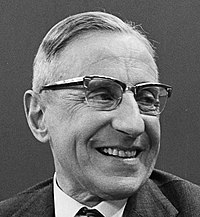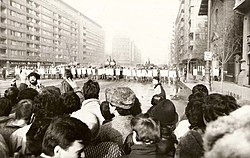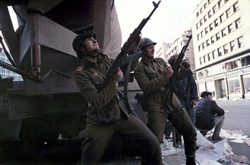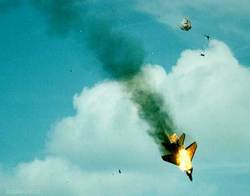Liothidian military intervention in Ommenlanden
| Operation Fraternity Operation Brüderlichkeit | |||||||
|---|---|---|---|---|---|---|---|
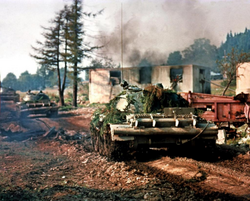 Liothidian tanks advancing toward Alkmaar on 29 May 1994. | |||||||
| |||||||
| Belligerents | |||||||
|
|
| ||||||
| Commanders and leaders | |||||||
|
|
| ||||||
| Strength | |||||||
|
|
| ||||||
| Casualties and losses | |||||||
|
55 injured 29 injured One aircraft shot down |
2,084 injured or captured Two aircraft shot down | ||||||
| 89 civilians killed or injured | |||||||
The Liothidian military intervention in Ommenlanden, officially known in Liothidia as Operation Fraternity (Liothidian:Operation Brüderlichkeit), was a week-long military operation, between May and June 1994, against the Ommish government under Johannes Alders.
The operation came at the climax of the Lost Decade, which was a continious economic and political crisis that emerged following the death of long-time leader, Karsten Kroon. The operation involved a significant portion of the Ommish military and 36,000 Liothidian soldiers. The relatively bloodless invasion ended with the storming of the government district in Alkmaar and the mass purge of the Ommish communist government.
The Liothidian military began an occupation of Ommenlanden while appointing new leaders, who in turn, launched Liothidian inspired reforms of the political, economic and social systems of the country. The invasion preserved Liothidia's influence over the country and the location of Ommenlanden within its sphere of influence, while bringing political and economic stability, it remains one of the most hotly debated military actions of the late 20th century.
Over 500 pro-Alders soldiers and police were killed, alongside 89 civilians who died in fighting or accidents.
Background
Ommenlanden had been under the rule of the All-Ommish Socialist Party since revolution of 1943, which had been fully-supported by Liothidia. With the outbreak of the Second Lio-Vannoisian War in 1945, Ommenlanden entered the war in alliance with Liothidia, being a significant player in the western front against Ostmark and XX. The war's end in 1951, left Ommenlanden significantly drained of manpower, wealth and industrial capacity, further entrenching its reliance on Liothidia. The election of Karsten Kroon as President in 1952, an unapologetic pro-Liothidian politician, led to the signing of the Treaty of Fraternity, Solidarity and Reconstruction between the two states, which granted Liothidia excessive access to Ommenlanden's mineral wealth.
Kroon however, instituted a series of political reforms throughout the 1950s that partially opened the economy and political systems, which he used to further entrench his position. By 1965, Ommenlanden had exceeded its pre-war economic position and saw sustainable and respectful growth. During this time, Kroon had amassed such support and power that he became the subject of an extensive cult of personality and the central source of power and authority in the single-party-state. Throughout the 1970s, with the implentation of Popular Socialism in Liothidia under Armin Stahl, Kroon became concerned that Liothidia was diverging from socialist thought to swiftly and regularly refused to follow suit, even as Liothidia's economy boomed as a result.
In 1980, Kroon suffered a stroke and withdrew from the public lime-light. His deputy, Gerard Nijboer assumed most of his duties and responsibilities. However, lacking his charisma and popular support, factionalism within the AOSP began to deepen and fracture party unity. In 1983, Kroon suffered a second stroke and died four weeks later on January 4 1984. Nijboer was elected as his successor, but failed to confront factionalism and disunity sufficiently, allowing for the division to breakout into political infighting and economic stagnation.
Lost Decade
Following the death of Kroon, the infighting within the AOSP escalated dramatically by 1985. Historically, the infighting has been categorised as "competing worldviews and visions for Ommenlanden's future." While these worldviews generally maintained commonalities in preserving socialism, they differed often greatly on content. The first faction, was the pro-Liothidian and pro-reform bloc known as the Keyser Club, named after Henk Keyser, Kroon's popular and competent Finance Minister. The other was the Provincialen, a faction that sought power for trade unions and workers' councils and federalisation, the other was the Kanaalgroep, a nationalist socialist orthodox group that sought Ommenlanden's independence from Liothidia.
Between 1984 and 1986, President Gerard Nijboer attempted to maintain a balance between the various factions, by implementing a mix of reforms promoted by all three. These reforms often contradicted one another and had serious negative effects on the country's economy. His implementation of stricter state controls in concession to the Kanaalgroep, decimated the capital reserves of the government and within months shortages of luxury goods followed. His implementation of reforms aimed de-centralising government disrupted chains of command and led to declines in education and healthcare standards, as local provincial governments competed with central government over policy. In April 1986, the AOSP launched an emergency congress to discuss the situation. This allowed all three factions to outmaneuver Nijboer, with a vote of no-cofidence, unseating and demoting him. Unable to appoint a new President by majority, they were forced to accept Premier Piet Rietveld as President. Rietveld was sympathetic to the Kanaalgroep and succeeded in securing several KG members as cabinet ministers.
However, the Keyser Club and Provincialen united at the 1987 congress to remove Reitveld by vote of no-confidence, leading to the election of Jan Thielen as President. Thielen was a self-proclaimed moderate who sought to end the economic consequences of the chaos in politics, however, he soon found to lack sufficient support for even modest reforms by the Kanaalgroep and Provincialen and resigned six months later. As an emergency candidate, Willem van Bergen was elected Acting President, a position he would hold until 1990.
Van Bergen succeeded in passing emergency economic motions through the Politburo, yet they failed to address the new chronic inefficiencies in the economy, which still overly relied upon agriculture and mining. This led to rising unemployment, further shortages and rapidly growing discontentment. In 1990, Van Bergen died in a plane crash while visiting northern Ommenlanden, he was succeeded by Hugo Borst who would serve until 1992, before being removed by the Party Congress in wake of his own failures to secure reform.
In 1993, mass protests and riots erupted across Ommenlanden in response to the chronic economic situation and the political instability. Unable to find common ground, the three factions continued to conspire against one another, until Johannes Alders, a member of the Kanaalgroep, promised to act in good faith, arguing that all three factions could see their desired reforms implemented. Alders stated that Ommenlanden could federalise, while maintaining close trading ties with Liothidia and increasing state control over the economy. Eager to avoid a popular uprising, the Congress elected Alders President. His crackdown succeeded in limiting disturbances, however, he used the security crackdown to detain several members of opposing factions, while declaring his intention to pull Ommenlanden out of Liothidia's sphere of influence.
The arrests and Alder's anti-Liothidian rhetoric caused deep concern within the Liothidian government, who saw Alders' agenda as vague enough to warrant concern its rivals would seek to break Ommenlanden away from Liothidia, endangering its economic and geopolitical interests.
Liothidia's position
Throughout the Lost Decade, the Liothidian government had assumed a belief that through the conflicting interests, no faction would gain overall control of the Ommish state. This was entrenched by First Secretary Armin Stahl's refusal to impede on Ommenlanden's political system, warning that overt influence would be a boon for the "extremist anti-socialist alliance factions."
However, Manfred von Weizsäcker, who succeeded Stahl in 1990, took the situation in Ommenlanden with deeper concern. He reportedly worried that continuing political instability would endanger the Ommish communist government and ostensibly endanger what Liothidia refers to as "Zentrale Sicherheit" (Central Security), the geopolitical ring of satellite states to Liothidia's west, east and south. In 1991, Von Weizsäcker ordered the People's Revolutionary Army to draw up plans for a military intervention to preserve the communist government.
In 1992, with the onset of mass protests and riots, the Liothidian government increased its intelligence staff at its Embassy compound and GID military officers established relationships with numerous counterparts in the Ommish military and pro-Liothidian factions. With the election of Johannes Alders as President, the Liothidian government under Von Weizsäcker set in motion the intervention, viewing Alders as a direct threat to Central Security over the mass protests.
Preparations
Eager to avoid alerting elements loyal to Alders, between 1993 and 1994, the Liothidian intelligence services worked tirelessly to secure support of key individuals within Ommenlanden's military, civil service and ruling party. The long-term Minister of Defence, Jan Provoost, shared no affinity for Alders or his agenda and was secured by Liothidian intelligence as early as November 1993. Other figures reportedly recruited by the Liothidians included the theatre commanders on the eastern border with Liothidia, who were ordered to keep sightings of Liothidian military units secret from the central government.
Throughout late 1993 and early 1994, the would-be putschists expanded their number to include officials from the Territorial Defence Force, Police and civil service. The Liothidians had identified a "Successor Administration" by December 1993 and arrange for them to be out of the country during the operation.
In December 1993, under cover of Christmas, the Liothidian military deployed select teams of its STROPAK special forces inside Ommenlanden. According to released Liothidian archives, the units were tasked with meeting up with pro-putsch Ommish special forces, but also to hide in close proximity to the residences of identified opponents of the operation and Alders loyalists.
From January until May, the People's Revolutionary Army deployed the roughly 36,000 strong force earmarked for the invasion to key locations across the border. Officially, these deployments were described as "practice logistical deployments." These growing number of soldiers went unreported to the Ministry of Defence.
The pro-Putsch Ommish officers amassed under them a force of roughly 16,000 soldiers, while other officers were convinced to ignore any call for aid by the central government. However, pro-Putsch leaders had warned the Liothidians by February 1994, that some elements of the Ommish Worker's Army and the People's Police Service would likely resist. In early May, the PRA had deployed ammunition and support equipment, while all aircraft in the Western Military District had been placed on high alert for immediate deployment into combat.
In April, the PRA confirmed that the operation would take place on 29 May.
Operation Fraternity
At approximately 02.00am on 29 May 1994, Liothidia invaded Ommenlanden. That night, 36,000 Liothidian soldiers and 1,000 tanks entered Ommenlanden along two axis of advance. These forces were comprised of units from the 3rd Army of the II Western Military District, backed by units of the 35th STROPAK Division who had been pre-deployed into the country in December 1993. The same time, pro-putsch forces of the OWA deployed forces to strategic points around Alkmaar.
At 03.00am, STROPAK forces stormed the residences of key government officials, detaining them. However, Finance Minister Jan Hoen, responded to noises downstairs by attacking one STROPAK soldier, who responded with gunfire, killing him instantly. Others detained included State Security Minister, Marten Joustra, which significantly damaged the government's response.
The same time, STROPAK special forces seized control of Karsten Kroon International Airport outside Alkmaar. The 150 plain clothed personnel were flown in the previous night by commercial carriers from Liothidian regional hubs. Having seized control of the airport, a Liothidian transport plane arrived and began unloading airborne troops, vehicles and supplies.
At 03.10am, pro-Putsch Ommish forces seized control of their respective bases and facilities, while 5,000 troops of the 2nd Army were deployed into the central districts of Alkmaar. This activity, along with sporadic reports of mutinies reaching the central government resulted in the deployment of Presidential Guard units and armed People's Police to the government quarter. Sporadic fighting between loyalists and putschists broke out at several military bases in northern Ommenlanden and at the Kapitaalverdedigingsstation.
By 04.00am, the Alders government had become aware of the Liothidian invasion and ordered what loyalist forces it had in the east to attempt a stalling action. At 04.36am, elements of the 13th Motor Geweer Division engaged the vanguard of the 27th Panzergrenadier Division near the village of Lauwersmeer. The engagement lasted 45 minutes and left the loyalist forces utterly destroyed.
By 05.00am, the Liothidian force had reached the outskirts of Alkmaar and entered the city proper twenty minutes later. By this time pro-Putsch forces had been engaged in house-to-house fighting with loyalists within the government quarter, they were later aided by the arrival of elite Liothidian armoured and mechanised forces who surrounded the quarter and began to bombard buildings used by loyalists.
At 07.22am, two loyalist Ommish Fe-20 aircraft were launched from an airstrip near the city of Stuifzand. These aircraft headed south toward Alkmaar. They were promptly engaged by two Liothidian Fe-26 fighters, the four aircraft came to blows 12km north of Alkmaar, with one Fe-19 shot down by an Fe-26, the surviving Fe-19 fired an air-to-air missile, striking one of the Fe-26 fighters, forcing the pilot to eject. The Fe-19 was in turn shot down by the surviving Fe-26.
The Alders government was finally removed from power at 07.43am, when Ommish and Liothidian military forces stormed the government quarter, backed by helicopter gunships and airpower, many of the loyalists surrendered. The President himself was apprehended at 07.41am in his office. He was promptly airlifted out of Alkmaar by helicopter to the airport and subsequently flown to Liothidia.
Reactions in Ommenlanden
Popular discontent toward the AOSP had declined since 1993, with Alders' crackdown on organised dissent, however, Alders never enjoyed significant support or legitimacy in the eyes of the general populace. The surprise and suddenness of the Liothidian invasion "numbed" the population according to journalists present during the operation. The lack of coherent opposition to the regime throughout the Lost Decade denied any pro-democracy movement the opportunity to rally against the Liothidian invasion or the coup.
However, in towns supportive of Alders, popular opposition was expressed in numerous spontaneous acts of nonviolent resistance. In these strongholds, people greeted Liothidian soldiers with arguments and reproaches. Every form of assistance, including the provision of food and water, was denied to the invaders. Signs, placards, and graffiti drawn on walls and pavements denounced the invaders, the Liothidian leaders, and suspected collaborationists. Citizens gave wrong directions to soldiers and even removed street signs (except for those giving the direction back to Rahden).
Of the 89 civilians killed or injured during the operation, 19 were harmed during the Liothidian invasion, mostly through car accidents and collisions with military vehicles. The remaining 61 were killed or injured during gunfights across Ommenlanden and in Alkmaar.
Disenchantment with the instability and economic stagnation of the Lost Decade, allowed the Shuurman government to accrue some support as it sought to restore normalcy to government and the economy, which had become the overriding concern of the general populace during the 1990s, rather than regime change.
Aftermath
Fall of Johannes Alders
Immediately after Alders' extraction from Alkmaar, Hendrik Shuurman, the leading commander of pro-putsch forces took to the national radio to announce an "emergency government for stabilising the nation." Loyalists were rounded up, disarmed and transported to facilities across Ommenlanden. While the remaining allies of Alders in the Party and legislature were detained throughout the day of the 30 May.
Liothidian forces were re-deployed throughout the country, to often isolated facilities away from populated places. Plain clothed agents remained, assisting the 'Emergency Government' in detaining Alders' loyalists, however, by 1995, they had also promptly detained or murdered at least 18 critics of the invasion and the subsequent occupation of Ommenlanden.
On June 1, Shuurman announced that his emergency government would give way to a new administration in the following weeks, while simultaneously implementing a series of reforms aimed at stabilising the economy and restoring public faith in the single-party regime. The protests that ultimately led to the Liothidian intervention dissipated, while the number of people disappeared increased threefold between June and July, with leaders of the previous riots and protest movements being targeted.
On June 10, Johannes Alders returned to Ommenlanden and was stripped of his posts, party membership and sentenced to life imprisonment in a televised Special Military Tribunals of the Ommish Worker's Army. He was accused of "betraying the party orthodoxy and inflicting unnecessary difficulty upon the hard working people." He died on December 3 1994, from septicemia according to Ommish records.
Liothidian occupation
Immediately after the successful removal of Alders, the Liothidian force was dispersed across Ommenlanden. Officially, the forces were to remain to "aid and support the stabilisation of Ommenlanden", yet no Liothidian or Ommish government official would give a timetable for their withdrawal. In most cases, the forces were deployed to Ommish military bases, while new facilities were constructed in rural and isolated regions.

According to NATA intelligence reports, the Liothidian military used its occupation to dramatically expand in-field logistics and facilities. Numerous radar installations were constructed across western and southern Ommenlanden, new depots and roads were constructed in directions toward the border with Ottonia and northward toward Ostmark. One Arthuristan government report described the moves as, "in the immediate term, the Ommish and Liothidian militaries appeared to operate completely independent of the central, albeit interim, authority in Alkmaar. What followed the intervention was the rapid construction of infrastructure necessary in any future conflict."
A Latin Army analysis described the occupation as, "truly shadowy in nature. The forces are deployed and housed away from public view, yet in such strategic positions that rapid deployments into urban areas would be assured. In short, they are out of sight, yet ever ready to pounce on any sign or indication of public or popular revolt."
The most dramatic nature of the Liothidian occupation was the oversized role KOMINSI played in aiding the interim government remove Alders loyalists and critics of the regime or the Liothidian invasion. In many cases, former Alders loyalists noted that KOMINSI overreached, targeting numerous Ommish who called for independence from Liothidia, be it politically or economically.
The occupation in this sense would come to an end in 2006, with the re-deployment of Liothidian forces to established formal bases at three locations in north, western and southern Ommenlanden. However, the role of KOMINSI in Ommish law enforcement and repression continues.
New government and reforms
On July 5 1994, the All-Ommish Socialist Party held an extraordinary congress to elect a new administration to succeed the Emergency Government under Hendrik Shuurman. Before any candidates put their names forward, Jan Boekhorst and Hendrika Tigelaar were presented as candidates for President and Premier respectively by Shuurman. He also made it explicitly clear that the duo had the full support of Liothidia.
On July 6, Boekhorst and Tigelaar were elected by the Congress unanimously and assumed their positions the same day. Both Boekhorst and Tigelaar were in Liothidia during the invasion on special Fact-Finding Missions by invitation of the Socialist Workers' Party in Rahden. Both had served as junior ministers under Kroon and Nijboer and were generally respected by the AOSP grandees that survived Shuurman's purge.
President Boekhorst addressed the nation on live television and vowed to "reform and repair Ommenlanden to ensure that continued prosperity is provided to all Ommish citizens and workers, and to ensure that never again does the Party fail the people in the way that we did." Between 1994 and 1999, the Boekhorst-Tigelaar administration implemented over 600 reforms in similar vein to the Popular Socialism reforms of Armin Stahl in Liothidia, with the opening up of the economy to private ownership and business, reduction in state command policies and reforms of state-owned enterprises along more corporate lines. The reforms by 2000 had resulted in renewed economic growth and increased standards of living.
Between 2000 and 2004, the administration went further, opening up the political system to trade unions and workers' councils in what many described as a "quasi-democratisation." Among the changes was the introduction of direct-democracy at the local level over key decisions, while city administrations were opened to the same. Many commentators during this period noted a significant reduction in state repression, censorship and increased transparency.
A series of studies by the Belisarian Institute for Public Opinion, argued in 2005, that the "intervention had succeeded beyond expectations. It had saved the communist regime at minimum, yet the success of the Boekhorst-Tigelaar administration cannot be discounted. According to our impartial studies, we believe as of this year, that 88% of Ommish support their system of government, while 80% have a positive view of the intervention and their incumbent government."
Analysis
The invasion and subsequent occupation of Ommenlanden caught many international powers off-guard. Many were surprised at the relative ease the Liothidians enjoyed in securing the capital and establishing a compliant puppet government through Hendrik Shuurman.
The speed of the invasion had left international powers with little time to formulate an official position. As one Vannoisian official remarked in 1995, “by the time we were ready to denounce it as an unforgiveable military invasion, it was over and Shuurman was in charge.” Others noted that the limited bloodshed, especially civilian aided the Liothidians in avoiding significant denunciation.
The invasion did raise concerns within foreign governments over the success of Liothidian special forces in decapitating the Alders government, with the detention or killing of senior ministers and officials, most of whom, would have been vital in rallying the country against the intervention. The capture of Karsten Kroon International Airport by plain clothed agents also sparked fears of repeat operations in the smaller neighbouring states in Central Euclea.
However, many in the People’s Revolutionary Army dismissed the operation as a major example of Liothidian strategic policies or doctrines. Within Liothidia, the success of the operation is overly credited to the domestic support of the intervention in Ommenlanden. In an tell-all interview in 1998, commander of the Liothidian forces during the operation, General Dieter Grenz said, “if we did not have the immense and invaluable support of the OWA [Ommish Worker’s Army], the operation would have either failed or denigrated into an all-out military invasion. Those officers who withheld intelligence of our deployments or preparations, those who cut lines of communication to deny the Alders government of our invasion were key.”
The success of the invasion itself, the speed of which the PRA crossed the border and reached Alkmaar, roughly 3 hours was heralded as an example of the army’s discipline and superior training. The role of STROPAK was also lauded, as such it is widely believed that Liothidian special forces recreate the operation regularly as part of their training regime.
Post-invasion activities
In the immediate aftermath of the invasion, the Liothidian military began reconstructing numerous bases and facilities throughout Ommenlanden. These included radar facilities, air-defence sites and logistical depots and hubs. Much of these facilities were located in southern and northern Ommenlanden, near borders with countries within the NATA organisation.
Military historians have opined that one key objective of the intervention may have been to “establish a situation where the Ommish government would grant a free-hand to the PRA to build the necessary logistics and infrastructure that would be required in the event of conflict with NATA.” In 2014, NATA noted that the intervention had left behind a “system of facilities that would enable rapid deployment and offensive action against member-states.”
One long-term effect was increased integration between the PRA and OWA. One Ommish dissident wrote in 2004, “the invasion led to the complete blurring of lines between the PRA and OWA. The latter was purged between 1995 and 1996 of Alders holdouts and all those who replaced the purged were Liothidian puppets.”
Political
The success of the intervention, however, came with the immense work carried out by Boekhorst and Tigelaar, who implemented Liothidian reforms across Ommenlanden. The success of the reforms stabilised the country and boosted economic growth, while Liothidian investment was offered to buttress the economic changes. The same time, the Boekhorst-Tigelaar administration instituted a nationwide media campaign aimed at boosting Liothidia’s image domestically, which offered credit for the economic improvements.
In 1995, Ommenlanden provided 18,000 soldiers to Liothidia’s 650,000 deployed during the Northern War (1995-1996), against Nekulaturnya.
In 2004, the pair were succeeded by Peter Leijten and Willem Schepers, who continued to implement Liothidian policies and economic reforms. The pair in 2006, formalised the presence of Liothidian forces in the country through the Treaty of Mutual Security and Defence, which granted Liothidia three major land-air bases in the north, south and west of the country. By 2010, the number of Liothidian forces in Ommenlanden had increased from 36,000 to 50,000.
Successive Ommish governments have maintained the close relationship, which according to economists has only deepened the country’s reliance on Liothidia economically speaking. Despite this, the success of reforms and the economy, alongside the partial opening up of the political system has renewed public trust and legitimacy in the communist government, ensuring a close ally and satellite state to Liothidia’s west.
